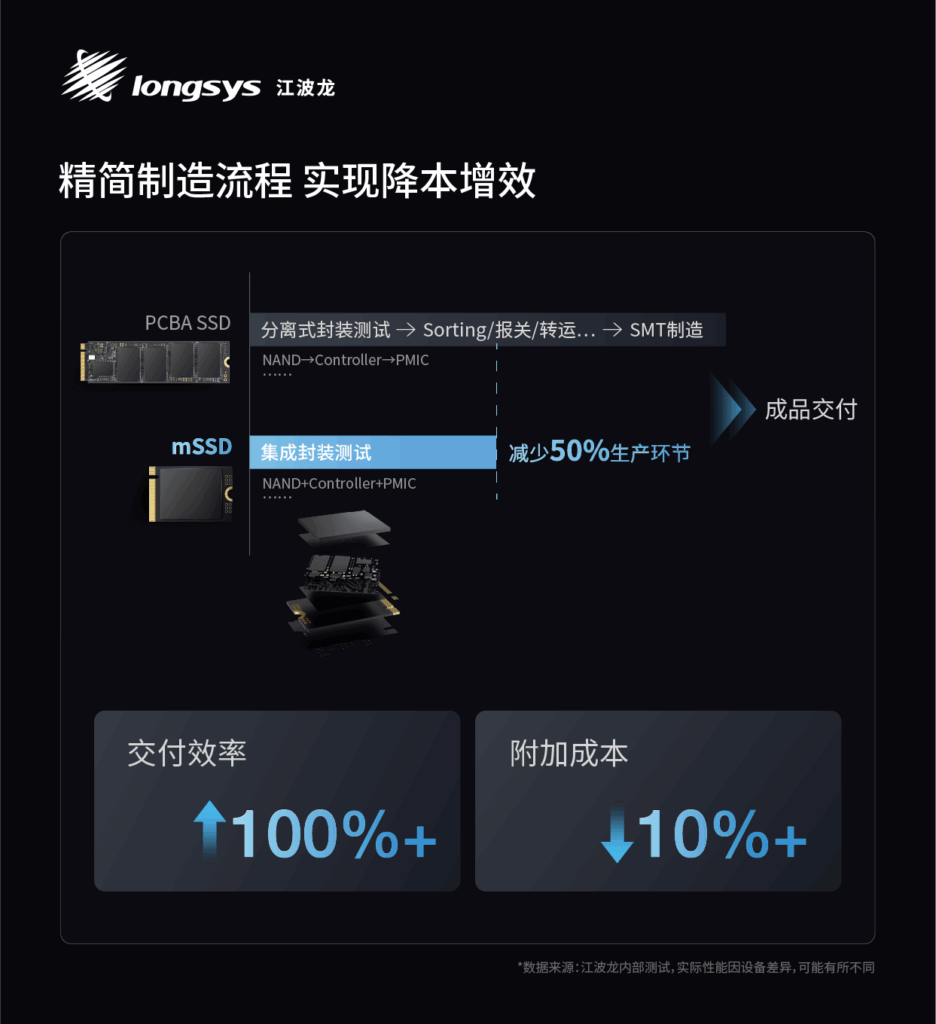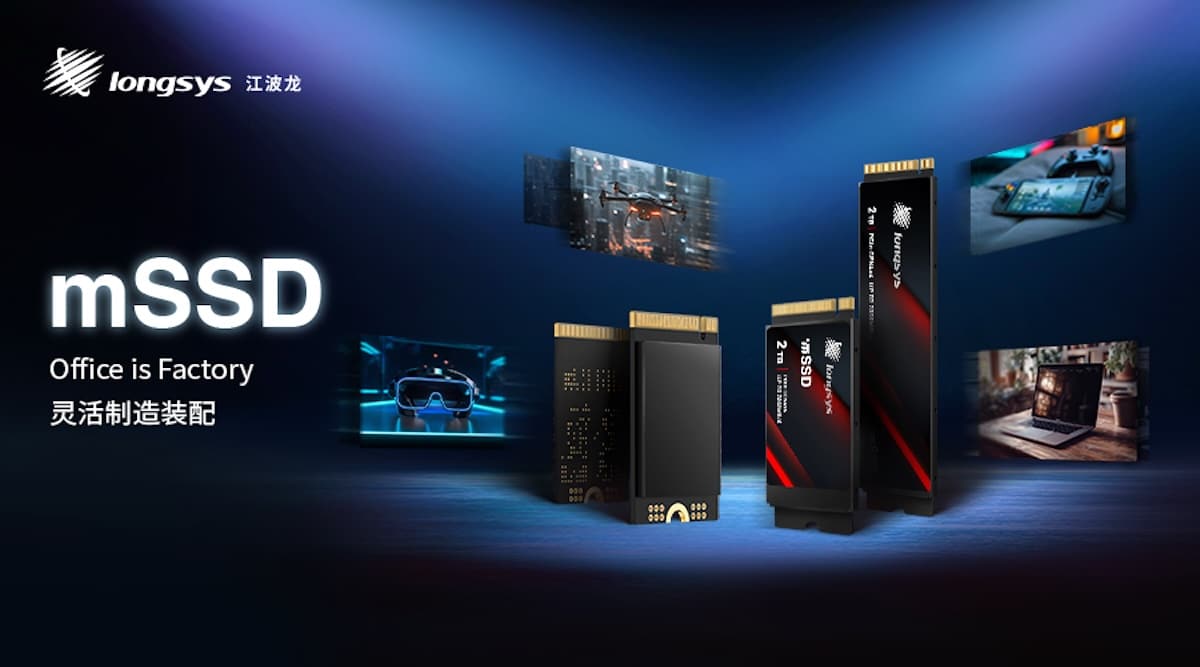The Chinese supplier Longsys —owner of Lexar— has introduced mSSD (Micro SSD), a redesign of the M.2 format that changes how NVMe units are constructed. Instead of mounting the controller, NAND, and power management (PMIC) separately on the board, the mSSD integrates all components into a single package (System-in-Package, SiP) that is mounted on a small PCB M.2 2230. The company describes it as the “first mSSD with integrated encapsulation” and credits it with improvements in quality, efficiency, cost, and flexibility, with an integrated cooling system as well.
Beyond the headline, the move has two interpretations: on one hand, industrial (fewer manufacturing steps and potentially fewer failures); on the other, product-wise (same bandwidth as a high-end PCIe 4.0 SSD but in a 20 × 30 × 2.0 mm body and 2.2 g). Pending commercial availability, Longsys states that the mSSD has already completed development and testing, has patents filed in China and internationally, and is “ramping up for mass production”.
What’s changing? From PCB with SMT to “all in one encapsulation” (SiP)
In a conventional M.2 SSD, the typical process is PCB + SMT: a blank board is populated with components (NAND, controller, DRAM, PMIC, passives) through multiple surface-mount assembly passes and reflow soldering; sometimes, in different factories, with intermediate transportation. Longsys replaces this pattern with a System-in-Package: chips go directly from the wafer and enter a single encapsulation where electrical connections, mechanical protection, and thermal management are performed.
According to the company, the SiP eliminates traditional soldering on the PCB, which cuts a common source of defects. The reference metric cited is DPPM (Defective Parts Per Million): compared to “almost 1,000 DPPM” (≈ 0.1%) typical in PCBAs, the mSSD aims for < 100 DPPM (≈ 0.01%), that is, one-tenth of the failure rate. Additionally, by eliminating several SMT steps and transfers between factories, Longsys estimates a total cost reduction > 10% along with lower energy consumption and reduced CO₂ footprint during manufacturing.
Key idea: the integrated encapsulation shifts the SSD’s quality assessment from “PCB quality” to “chip quality,” with fewer steps, less transportation, and — if the numbers are confirmed — fewer in-field failures.
Format: baseline M.2 2230, tool-free adapter for 2242 and 2280
The mSSD is shipped as M.2 2230 (20 × 30 mm). To enable use in M.2 2242 and M.2 2280 slots — common in laptops and PCs — Longsys offers a clip-on adapter (tool-free) that transforms the “micro” mSSD into a standard-sized module. The M.2 connector remains the same; what changes is how the card is populated.

This solution aims to reduce SKUs (a single “core” mSSD adaptable to different lengths) and streamline logistics. It also makes maintenance easier: compared to “on board” soldered solutions, one mSSD can be removed and replaced like any M.2.
Integrated cooling: graphene, aluminum, and thermal silicone
The SiP compacts the components but doesn’t avoid the robust cooling needed by modern PCIe SSDs: thermal management. Longsys equips the mSSD with a graphene pad and, in the 2280 adapter, adds a high-conductivity aluminum alloy structure, with two casings joined by thermal silicone that also extracts heat from the rear side, increasing the effective surface area for dissipation. The upper casing is lightened to maintain the 2 mm thickness where the SiP occupies space.
Internal tests by Longsys show that the 2230 mSSD without an adapter reduces performance when temperature rises to around 28 seconds, dropping to about 1,500 MB/s in the worst case. With the 2280 adapter with heatsink, the performance decline occurs at around 121 seconds, with a minimum speed near 3,750 MB/s. These are manufacturer data, useful as an indicator that packaging and cooling can extend the boost, but awaiting independent validation.
Performance and efficiency: PCIe 4.0 today, ready for Gen5 “when thermal management aligns”
In this initial wave, the interface is PCIe 4.0 x4 (NVMe). Longsys states:
- Sequential read: up to 7,400 MB/s
- Sequential write: up to 6,500 MB/s
- 4K random: 1,000,000 IOPS read and 820,000 IOPS write
These numbers place the mSSD in the high-end of PCIe 4.0. Looking ahead, the manufacturer considers a transition to PCIe 5.0 “when the thermal management of Gen5 becomes manageable”; they note that PCIe 5.0 SSDs are already gaining efficiency, so the transition could accelerate.

Capacities are expected to range from 512 GB to 4 TB, with TLC or QLC (under study). Power consumption meets protocol thresholds (e.g., NVMe L1.2 ≤ 3.5 mW), with peaks within specifications, according to the technical note.
Why does this architecture shift matter?
1) Quality and reliability. If the SiP truly reduces DPPM from ≈ 0.1% to 0.01%, it could make a tangible difference in RMA and support — beneficial for data centers, enterprise notebooks, or industrial equipment. Less soldering also means reduced risks from vibration or temperature fatigue.
2) Total cost. The savings of > 10% not only improve margins; they also pave the way for more affordable SSDs in categories driven by price (e.g., handheld gaming or ultraportables with slots 2230).
3) Manufacturing carbon footprint. Eliminating high-energy SMT stages reduces energy use and emissions per unit, aligning with ESG criteria for OEMs and operators.
4) Product design. A “core mSSD” that adapts via clip to 2242/2280 simplifies inventory and service, and enables customization (Longsys mentions UV printing and on-site assembly under their “Office is Factory” concept).
5) Compactness. The 2230 size broadens the range of ultra-thin or embedded devices that can deliver high-performance 4.0 without compromising space.
What remains unknown (and worth monitoring)
- Release dates and sales channels. The mSSD is “ramping up for mass production,” but no commercial schedule or pricing has been announced yet.
- Controller and NAND brands. The SiP abstracts brands, but performance (TBW, wear leveling, firmware) depends on binning and the controller.
- Endurance (TBW) and warranty. Specific TBW ratings per capacity and years of warranty are not yet detailed; key info for laptops and professional work.
- DRAM / HMB. The note does not clarify whether the SiP integrates DRAM or utilizes HMB (Host Memory Buffer).
- Independent validation. Thermal and throttling metrics are provided by the manufacturer; independent reviews are awaited.
Initial target applications
- Thin laptops and ultrabooks with M.2 2230 slots.
- Consoles and handheld PCs currently using 2230 that suffer thermal throttling.
- Drones, VR/AR, edge computing: compact spaces requiring sustained performance.
- OEM/ODM seeking unified SKUs and simpler supply chains.
Quick facts about the mSSD (according to Longsys)
- Base format: M.2 2230 (20 × 30 × 2.0 mm, 2.2 g)
- Interface: PCIe 4.0 x4 (NVMe); Gen5 under study
- Performance: up to 7,400 MB/s read, 6,500 MB/s write; 1,000,000 / 820,000 IOPS 4K
- Capacities: from 512 GB to 4 TB (TLC/QLC)
- Architecture: System-in-Package with controller + NAND + PMIC + passives
- Quality goal: < 100 DPPM (≈ 0.01%) versus ≈ 1,000 DPPM (≈ 0.1%) in PCBAs
- Cooling: graphene pad (2230) + 2280 adapter with aluminum and thermal silicone; tool-free assembly
- Power: NVMe L1.2 mode ≤ 3.5 mW (according to specs)
- Status: developed and tested; patents pending; ramping to production
Conclusion
Longsys’s mSSD introduces a structural evolution of the M.2 format: from PCB assembly to integrated encapsulation. If its failure rates, costs, and thermal performance are confirmed, it could become a standard platform for compact SSDs in laptops, consoles, and embedded devices, with less RMA and more design flexibility. Key uncertainties —such as release dates, TBW, firmware, and independent validation— will determine market reception, but the trend is clear: less soldering, more integration.
FAQs
What exactly is an mSSD, and how does it differ from a traditional M.2 SSD?
The mSSD is a Micro SSD that integrates controller, NAND, PMIC, and passives into a single encapsulation (SiP) mounted on a M.2 2230. In a traditional M.2, these components are soldered separately onto the PCB (PCBA + SMT). The SiP reduces production steps and eliminates solder joints, which — according to Longsys — lowers the DPPM and costs.
Will it be compatible with M.2 2242 and 2280 slots in laptops and PCs?
Yes. Longsys offers a clip-on adapter that converts the 2230 mSSD into 2242 or 2280 sizes, keeping the M.2 connector. The adapter adds an aluminum structure and thermal pads to improve dissipation and sustain higher speeds for longer.
What performance does it offer and how does it handle thermal throttling?
For PCIe 4.0 x4, up to 7,400/6,500 MB/s in sequential read/write and 1,000,000 / 820,000 IOPS in 4K random. In internal tests, the 2230 mSSD reduces speed at around 28 seconds due to temperature, dropping to about 1,500 MB/s. With the 2280 heatsink adapter, throttling starts at ~121 seconds with minimum speeds near 3,750 MB/s. These numbers are manufacturer data; independent reviews are pending.
When will it be available, and what capacities will it come in?
Longsys states it is in ramp-up for mass production after completing development and testing. No official release dates or prices yet. Capacities are expected to range from 512 GB to 4 TB, with TLC or QLC (under study). Initial interface will be PCIe 4.0, with PCIe 5.0 support when thermal management permits.
Does this offer environmental benefits compared to traditional SSDs?
By eliminating several high-energy SMT steps (soldering, reflow) and transports between factories, Longsys claims lower energy use and CO₂ emissions during manufacturing, along with a total cost savings > 10%.
Summary: Longsys’s mSSD advances the M.2 format by transitioning from PCB assembly to integrated encapsulation. If its failure rates, costs, and thermal performance are validated, it could establish a new standard for compact SSDs in laptops, consoles, and embedded applications, with less RMA and greater OEM flexibility. Remaining questions — release schedules, TBW, firmware, independent testing — will influence market acceptance, but the direction is clear: less soldering, more integration.
FAQs (Frequently Asked Questions)
What exactly is an mSSD, and how does it differ from a traditional M.2 SSD?
The mSSD is a Micro SSD that combines controller, NAND, PMIC, and passives in a single encapsulation (SiP) mounted on a M.2 2230. Traditional M.2 SSDs have these components soldered separately onto the PCB (PCB + SMT). The SiP reduces manufacturing steps and eliminates solder joints, leading to lower DPPM and cost savings, according to Longsys.
Will it be compatible with M.2 2242 and 2280 slots in laptops and PCs?
Yes. Longsys provides a clip-on adapter that converts the 2230 mSSD into 2242 or 2280 form factors while keeping the same M.2 connector. The adapter adds an aluminum structure and thermal pads for better heat dissipation and sustained performance.
What performance can I expect, and how will it handle thermal throttling?
For PCIe 4.0 x4, up to 7,400 MB/s read and 6,500 MB/s write, with 1,000,000 and 820,000 IOPS in 4K random access. Internal tests show speed drops at around 28 seconds due to temperature, to about 1,500 MB/s. With the 2280 heatsink adapter, throttling begins at approximately 121 seconds, with minimum speeds near 3,750 MB/s. These are manufacturer data; independent validation is pending.
When will it be available, and what capacities will it come in?
Longsys indicates that the product is in ramp-up for mass production. No specific release dates or prices are announced yet. Capacities are expected from 512 GB to 4 TB, with TLC or QLC (under evaluation). Initial interfaces will be PCIe 4.0, with support for PCIe 5.0 once thermal management is manageable.
Does this design offer environmental benefits compared to standard SSDs?
By eliminating several energy-intensive SMT steps (soldering, reflow) and reducing transports between factories, Longsys claims lower energy consumption and CO₂ emissions during manufacturing, with a cost reduction of over 10%.
In a nutshell: Longsys’s mSSD propels the M.2 format into the realm of integrated encapsulation: it’s more compact, potentially more reliable, and easier to produce. If it delivers on its promises, it could inaugurate a new “micro” SSD category with performance of 4.0 suitable for space-constrained environments where every millimeter counts.
Source: Longsys

